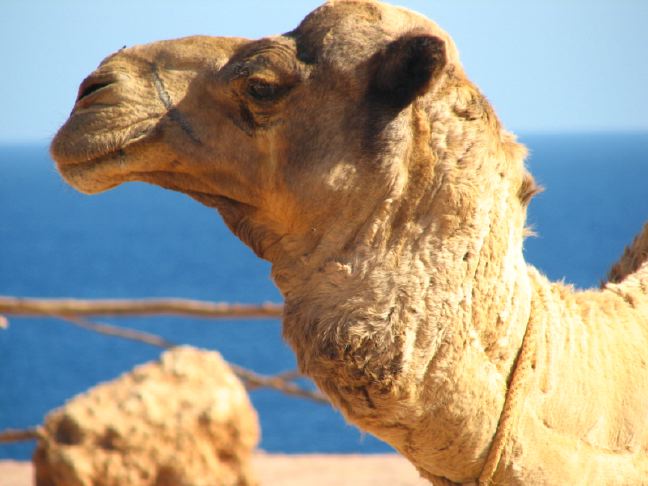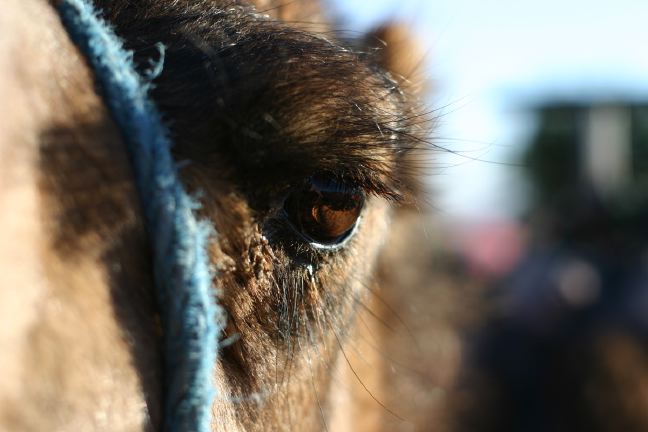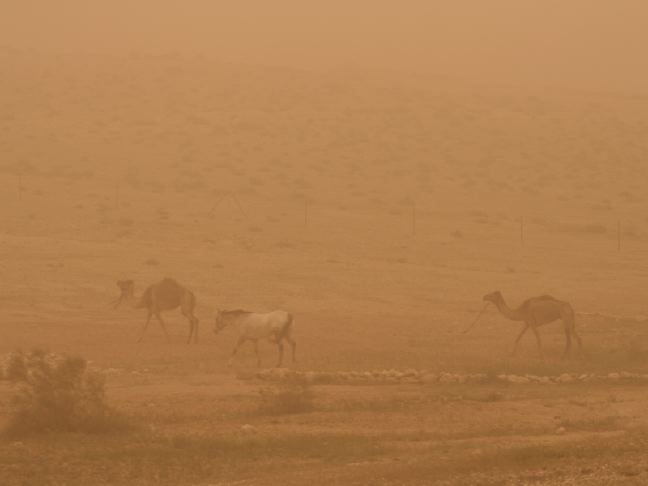|

Profile of a camel.
Image Source: Rain Rannu
/ License under Creative Commons
2.0
Available in two desktop sizes:
1024 x 768 || 800
x 600
The camel's head, though small, is one of its most interesting features. It has two
large eyes on either side of the head. Each eye is shaded from the noonday sun by
a projecting ridge of bone that thick bushy eyebrows sit on. [23]


Image Source: Thomas
Hobbs / License under Creative
Commons 2.0
The eye itself is protected from sand by two rows of extra long eyelashes, one on
the upper eyelid, and one on the lower eyelid. In addition to this, each eye also
has a very thin third eyelid that moves with a side to side motion, front to back.
These can act as a windshield wiper brushing away sand, or can close to protect the
eye while still allowing the camel to see. [24]


Two camels and a horse weather a sandstorm.
Image Source: Ilan's Photos
/ License under Creative Commons
2.0
Available in two desktop sizes:
1024 x
768 || 800 x 600
In this way, a camel can often see well enough to keep walking in the midst of a
sandstorm. [25] Glands in the camel's eye supply a lot of water in order to keep the eye
moist under extremely dry conditions. Located far back on the head are small rounded
ears. These ears are covered in hair, including the inside of the ear, which helps
keep out airborne sand and dust. [26] The camel's valvular nostrils are lined with
hair and work on the same principle as the ears to protect it from airborne sand
and dust. [27] A camel's nose is also designed to trap moisture from the lungs when the
animal exhales, thereby saving water. [28]
Camels are mobile browsers and have a deeply split upper lip. Their split lip is
ideally suited to stripping leaves from even the most prickly trees and shrubs. With
their long neck, they can reach 11 1/2 ft. (3.5 m) high and can feed on tough thorny
plants that even sheep and goats would pass over. [29] They can do this because of stiff hairs on
their nose that permit them to push their way into thorny plants and thick skin inside
their mouth that thorns cannot pierce. [30] They also like (even need) extremely salty
plants that grow at salt lakes and other locations. Inside the camel's mouth are
34 strong sharp teeth, that can be used as weapons, as well as for feeding. [31]
Although camels will normally select the freshest vegetation available, when food
is scarce, they are omnivore. This means they eat everything, fresh plants, dried
plants, bones, fish, meat, leather, and even on occasion their owner's tent. Camels
are called ruminant feeders, because they do not chew their food before swallowing
it. Instead, later after feeding, they regurgitate some of it (which is now politely
called cud) and finish chewing it. Then, it's three chambered stomach can complete
the digestion. [32] When a camel cannot find food, it's hump will shrink, droop to one side,
or even slide off the camel's back to one side. However, the hump will rapidly return
to size in a few weeks once the camel finds food. [33]
|